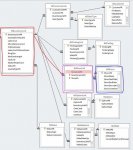I have a list box that allows multiple selections [Inventory]. I also have a combo box that has multiple selections [Shows].
Right now, user selects from list box and from a combo box and clicks a button. On button click, the items from the list box are associated with the PK from the combo and stored in a junction table. This allows me to quickly associate many inventory items to one show.
I realized that there I currently have no way to prevent duplicate Inventory+show records in the junction table besides having a composite key. This would be fine except no records get inserted into the junction table if there's a duplicate entry.
Ideally, I think that the user should select from the combo box [Shows]. This should narrow down what shows up in the list box [Inventory] in a way that Inventory items already associated with the show are not displayed.
If I have 10 Inventory items and Inventory items 1-5 are already associated with Show 1; after I select the combo box, the list box only displays Inventory items 6-10.
Here's the associated code
Right now, user selects from list box and from a combo box and clicks a button. On button click, the items from the list box are associated with the PK from the combo and stored in a junction table. This allows me to quickly associate many inventory items to one show.
I realized that there I currently have no way to prevent duplicate Inventory+show records in the junction table besides having a composite key. This would be fine except no records get inserted into the junction table if there's a duplicate entry.
Ideally, I think that the user should select from the combo box [Shows]. This should narrow down what shows up in the list box [Inventory] in a way that Inventory items already associated with the show are not displayed.
If I have 10 Inventory items and Inventory items 1-5 are already associated with Show 1; after I select the combo box, the list box only displays Inventory items 6-10.
Here's the associated code
Code:
Option Compare Database
Option Explicit
Private Sub cmdAddRecords_Click()
Dim strSQL As String
Dim db As DAO.Database
Dim rs As DAO.Recordset
Dim ctl As Control
Dim varItem As Variant
On Error GoTo ErrorHandler
Set db = CurrentDb()
Set rs = db.OpenRecordset("tblShowLink", dbOpenDynaset, dbAppendOnly)
'make sure a selection has been made
If Me.lstItem.ItemsSelected.Count = 0 Then
MsgBox "Must select at least 1 product"
Exit Sub
End If
If IsNull(Me!cboShow) Then
MsgBox "Select a show"
Exit Sub
End If
' If Not IsNumeric(Me.txtOtherValue) Then
' MsgBox "Must enter numeric Other Value"
' Exit Sub
' End If
'add selected value(s) to table
Set ctl = Me.lstItem
For Each varItem In ctl.ItemsSelected
rs.AddNew
rs!InventoryLinkFK = ctl.ItemData(varItem)
rs!ShowFk = Me.cboShow
rs.Update
Next varItem
MsgBox "These items have been added to the show"
ExitHandler:
Set rs = Nothing
Set db = Nothing
Exit Sub
ErrorHandler:
Select Case Err
Case Else
MsgBox Err.Description
DoCmd.Hourglass False
Resume ExitHandler
End Select
End Sub

